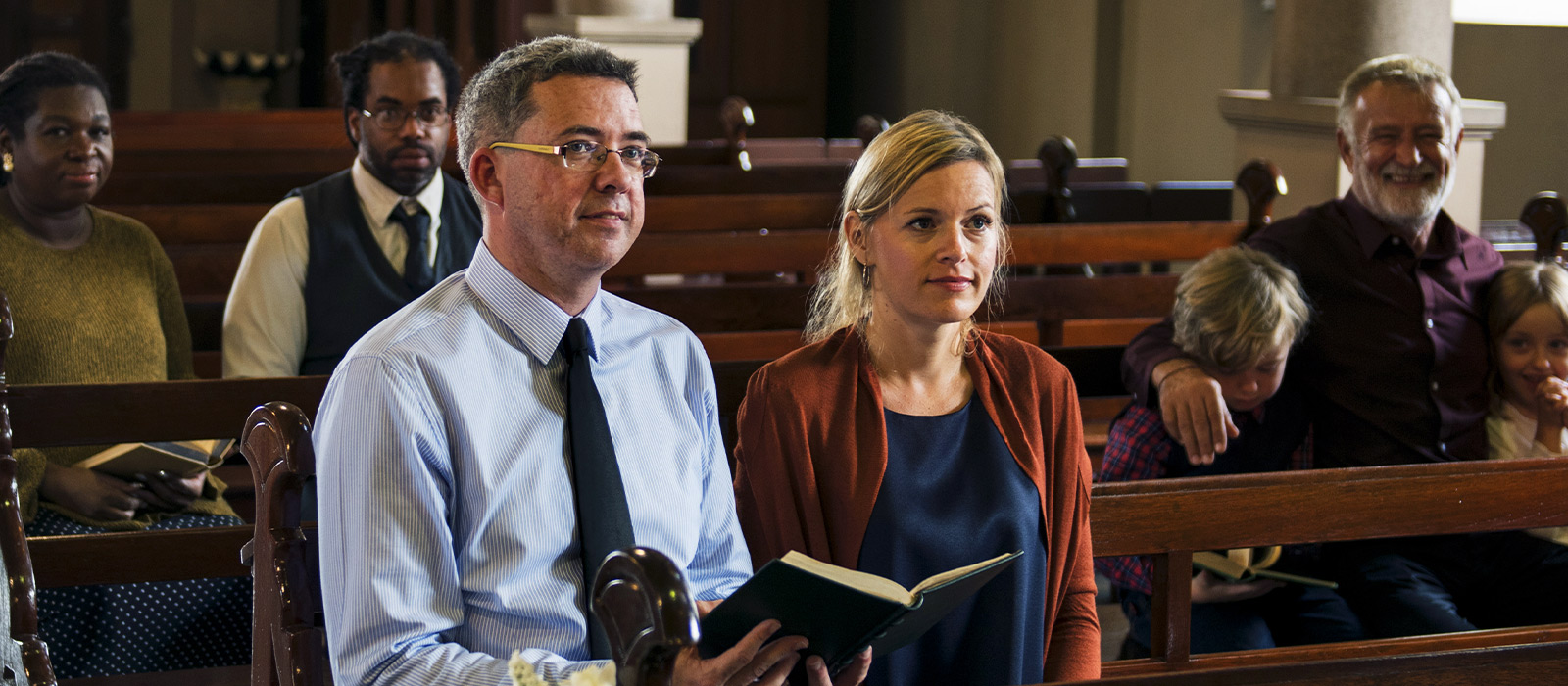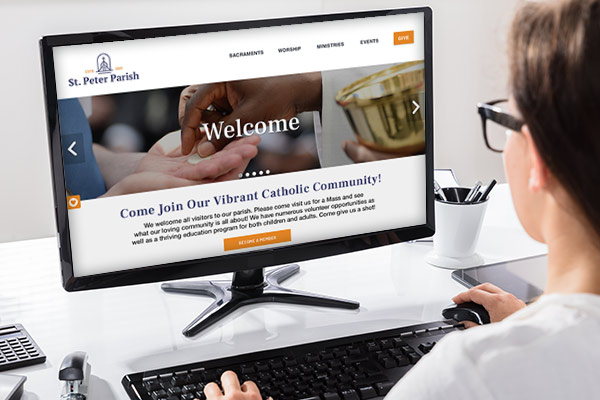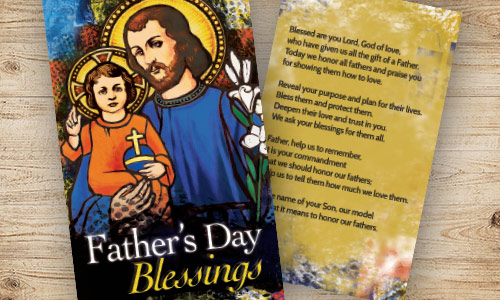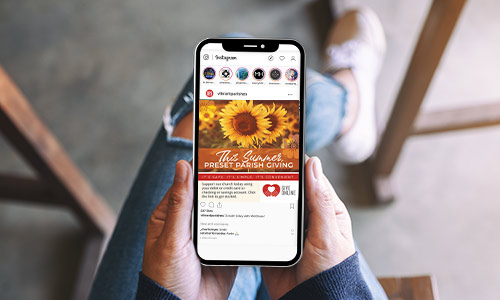In This Issue
May
FEATURED ARTICLES
- The Power of the Parishioner Email
- Visitor to Parishioner
- Website Navigation
- Managing Your Social Media
AT-A-GLANCE

The Power of the Parishioner Email

More parishes are adding an additional line to their new member registration form: email address. For the churches that rely on postal mail and the weekly bulletin to inform and inspire their parishioners, it may seem a little unclear as to why they should maintain an email list of their parish members. But there are so many advantages to using this electronic form of communication. Read on for some compelling points to the many benefits of collecting and maintaining your email list.

Easy Ways to Turn Long-term Visitors into Faithful Parishioners
Do you see familiar faces in your pews that don’t match to a name on the parish membership roster? You’re not alone. In recent years, not only are younger generations becoming less religious, but those who are religious are becoming less “rooted” in one particular community (we’ve all heard of the rising of Roamin’ Catholics, those who visit a different church every Sunday). A Gallup Poll released in early 2021 reveals that, for the first time ever, less than half of Americans report belonging to one particular worship community — a downward trend that has been steeper for Catholics than for other faiths.
But our parish communities require that sense of rootedness, and the financial support, that comes with a devoted membership. And if you’re seeing the same visitors return again and again, it’s likely that membership may be on their mind. If you’re wondering how to turn some of those familiar faces into members of your parish family, here are tips for easy ways to start.
Provide Brief Education on the Importance of Parish Membership
It’s just better to be a parish member than a parish visitor. Use the bulletin or back of the worship aid to emphasize the importance of membership. Members are more easily able to access sacramental privileges because they have an existing relationship with the parish and with a priest, and there are often financial benefits like school tuition reduction associated with membership. But on a deeper level, there is a profound meaning attached to the idea of belonging to a parish family — a concept that has faded from culture in recent decades. Membership is a powerful statement that says: This is our community. This is where we worship. This is who we are.

Make it Simple
Many of these visitors may have “parish registration” on their to-do list but never seem to get around to calling the office. Make it easy for people by offering registration on your parish website, and publicize that this is an option. Host a monthly signup after Mass, when people are already at church, or have a table out at each event your parish holds. Equip ushers with cards for people to fill in their personal information, so a staff member or volunteer can call them and complete registration later. Drive home the point that this is a quick and almost effortless process that will afford them great spiritual and practical benefits for years to come.
Make it Interesting
Get everyone excited about the prospect of increasing membership. To capture people’s attention, make it a contest (“Let’s get everyone signed up to be members by Father’s birthday! By the parish’s patronal feast day! By Easter!”) or a raffle (“Register and your name is entered to win!”).
Roll Out the Welcome Wagon
Joining a new community can be intimidating, especially if the new member is unmarried and childless. Does your parish have a welcoming committee tasked with reaching out to new parishioners to help them become part of parish life? Even a simple phone call or email of welcome from a fellow parishioner could make all the difference. If the new parishioners are comfortable, include a short introduction in the bulletin to help people get to know them. Make it known that your parish embraces its new members, and new members will be more eager to join.
Keep Reminding Them
Never doubt the power of brief announcements before or after Mass, perhaps delivered by representatives of different councils, clubs or groups within the parish. Help visitors to understand the vibrancy of parish life that awaits them if they join. Print testimonies in the bulletin from parishioners speaking to what parish membership has brought to their lives both spiritually and socially.
Engaging your parishioners is an ongoing job, but we can help! Check out “3 Ideas to Build Your Church Community Post-Covid” for some helpful ideas moving past the pandemic.

Website Navigation for the Best User Experience
If your parish is like most out there, no doubt you have a lot to share with the world. From Mass and confession times, listing of ministries, ways to volunteer, descriptions of sacraments, and requirements for infant baptism and matrimony, there is a lot to unpack. But just because you need it on your website, doesn’t mean it’s worthy of a “front and center” position in your navigation menu.
When everything you have is deemed “essential” to each staff member and the ministries they run, you need to come up with a way to make it easy for those who might not think that way to find what they need on your website. Read on for five ways to effectively set up your website navigation.
1. Focus on the “Big 3”
Generally speaking, there are three main reasons why someone will visit your parish website: for your contact information, to find out your Mass/confession times, and to give online. Knowing this, be sure that these are easily accessible on your website — in particular, your homepage. Some places we’ve seen contact information and Mass times placed is in the footer and right on the homepage. For online giving, this call to action should be placed as a static button on each page, usually in the right-hand side of the header.
Other information, such as ministry descriptions, sacramental information, annual reports, blogs, and online formation, can be placed within the navigation and not necessarily the top-tier menu.
2. Use Your Navigation to Tell Your Story
Instead of using very direct, specific titles, churches are beginning to use “softer” words in order to give people a better feeling of what to expect from their parish. Instead of, for example, “Mass Times, Contacts, Online Giving” for the header, we’re starting to see “Worship, Connect, Give” as drop-down menu titles.
Under that first tier, this is where you can find Mass/confession times and sacramental preparation (Worship), contact information, bulletins, upcoming events, and clergy and staff directory (Connect), and online giving and volunteer opportunities (Give).

3. Remember that Less Is More
You may be tempted to include everything you could possibly have on your website, so as to make everyone happy. From the Catechism of the Catholic Church to the United States Conference of Catholic Bishops, to your local diocese, you may want to start pulling information from these reputable sites to make sure you “cover all your bases.” But just because you can, doesn’t always mean that you should.
Keep in mind that if someone is searching for a broader topic about the Catholic Church, they probably won’t find it through a search engine. And you know what? That’s OK! The less clutter you have on your website, the easier it will be for people to find the information that pertains to your church. They won’t need to sift through citations and blog posts and news from the Vatican in order to find out how far in advance they need to register for marriage, or sign up for infant baptismal preparation.
4. Keep Navigation Tiers to Less Than 3 Deep
OK! So now you have your chosen menu headers and are starting to set up your navigation. Like a tree with various branches, you might find that one category naturally “falls” under another. But again, just because you can add it to the drop-down, doesn’t mean it needs to be there.
Keep your drop-down navigation to, again, just the basics, in order to keep your website as clean as possible. This will help to keep clutter to a minimum and allow for a sleeker look. You can keep this information on your website by adding them as links to specific pages that they fall under (for example, add a link to the parish wedding readings on the matrimony page).
5. Remember to Avoid Insider “Language”
Finally, keep in mind that your audience doesn’t necessarily speak the same Church “speak” that you as a staff do, so use terms and words that the average person in the pew will understand. Avoid formal titles that are typically only heard in staff meetings or a seminary class, as well as any parish-specific acronyms that wouldn’t make sense to the average Joe.
So, instead of using words such as Catechesis, RCIA, or Acolyte as some of your headers, go ahead and “rename” them to something that others would more easily understand, such as Church Teaching, Becoming Catholic, or Altar Servers.
Now that you know how to set up your navigation, it’s time to plan out your perfect website. Check out “Creating a Welcoming Parish Website” for some great aspects to consider, and connect with us to create your next website at 4lpi.com/solutions/catholic-church-websites

Is a Social Media Management Platform Right for your Parish?
Research is showing that social media platforms like Facebook, Instagram, and Twitter boast 3.7 billion users worldwide, an increase of 5% from 2020. Clearly, social media is a vastly effective tool when it comes to reaching the public, whether you’re a commercial business peddling a product or a Catholic parish looking to spread the Good News. These days, the internet really is the public square.
“Social media is fundamentally changing how people communicate,” writes the United States Conference of Catholic Bishops on its website. “Our Church can not ignore it; in fact, it is our responsibility as Catholics to bring the Church's teachings into what Pope Benedict XVI called the ‘digital continent.’”
But how each individual parish community embarks on that “digital continent” will look different. When deciding what kind of social media presence your parish wants to curate, there are important points to keep in mind that have to do with demographics, accountability, ease of use, and more. Who do You Want to Reach?
An important factor to consider is the average age of your parishioners — or the average age of people you want to reach. A Pew Research Center survey from 2021 indicates that 72% of Americans use some form of social media. It’s a number that does tend to drop with age, however — about 45% of adults age 65 and older report doing so. Usage of social media by platform can also depend heavily on age, gender, ethnicity, and income. Older adults are more likely to use Facebook and less likely to use Instagram and YouTube; the younger crowd shows up for Facebook as well, but loves Instagram and Snapchat, Twitter and WhatsApp, too. WhatsApp, in particular, has shown itself to be especially popular with the Hispanic community over the past few years of Pew Center studies.

Managing Your Online Presence
If your parish is going to establish a social media account, it’s advisable that only a few people have posting privileges so that your online presence is clean and consistent. Many parishes who decided to take their evangelization efforts online feel that the use of a management tool like Hootsuite or Buffer is essential. Not only does it save staff time in posting, but additional resources are often included and posts can be easily scheduled ahead for certain times.
If you’re looking for engaging and fresh content for your social media presence, be sure to check out all that is available on WeCreate, our Art & Media platform. Evangelize your community with the latest in stock photography, church clip art, Catholic prayers, weekly Gospel reflections, and more (psst, it’s also a FREE add-on to your bulletin contract!).
What Social Media Management Platform Is Right for You?
Here’s a quick rundown of some of the most popular social media management tools:
Hootsuite
More than 18 million customers choose Hootsuite to manage their social media accounts, gaining access to a social analytics dashboard that shows top-performing content and offers personalized insight. Hootsuite also allows customers the opportunity to connect their social networks across apps, and offers courses taught by professionals.
Sprout
Sprout aims to get you “from overwhelmed to empowered” by streamlining your engagement with your social media channels. Sprout can publish content, evaluate the performance of your posts, help you respond to messages quickly, and much more.
Buffer
Buffer allows customers an easy way to reach their audience through scheduled posting across networks like Facebook, Instagram, Twitter, and Pinterest while providing analysis on engagement and resources for improving.
Looking for new ways to engage and inspire your parishioners using social media? Check out our blog, “4 Social Media Trends to Watch In 2021.”
AT-A-GLANCE

Celebrate the Fathers in Your Parish
Fatherhood isn’t a job — it’s an adventure! This Father’s Day, honor the commitment and sacrifice of these men in your parish. Give them a tangible keepsake to hold on to with this beautifully designed prayer card. Available in English and Spanish.

Double Online Giving!
Interested in increasing your parishioner contributions, but don’t have the time needed to do it? With the WeShare Engagement Campaign, you have the potential to double donor donations with minimum effort on your part. Download and share your parishioner contact list with us, and we’ll reach out to them on your behalf. It’s that simple!

Church Bulletins That Inspire & Engage … FREE!
Every week, our customers count on us to deliver high-quality, color-filled bulletins at no cost to their parish. It’s our new digital print technology that makes vibrant color throughout the bulletin possible, and it’s our ability to sell more advertising that makes them free. Join our family today!

Digital Catholic Art & Content
With WeCreate, you’ll find the latest in stock photography, clip art, prayers, Gospel reflections, children’s art and activities, and more! And whether you’re looking to customize an attractive flyer for the upcoming bake sale, or seasonal clip art for the weekly bulletin, our templates make it easy for you to make it your own.
In This Issue
May
FEATURED ARTICLES
- The Power of the Parishioner Email
- Visitor to Parishioner
- Website Navigation
- Managing Your Social Media
AT-A-GLANCE
More resources
- DIGITAL CATHOLIC ART & CONTENT FOR EVERY WEEK
With WeCreate, you’ll find the latest in stock photography, church clip art, Catholic prayers, weekly Gospel reflections, and more to make your communications engaging and vibrant.
Learn more - STRENGTHSFINDER: A TOOL FOR SELF-DISCOVERY
The Clifton StrengthsFinder is one tool that helps us understand our self in terms of the person God created.
Click here to learn more. - THE STEWARDSHIP OF THE GOOD SAMARITAN
Are you and I required to respond to the daily call of Jesus Christ? No. True stewardship requires nothing of us because true stewardship is all about giving of oneself freely. ”
Click here to read more.
